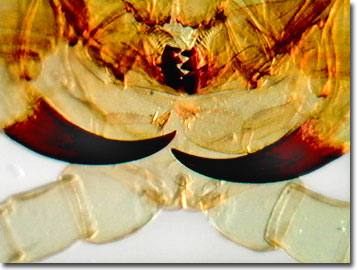Oblique Digital Image Gallery
Centipede Poison Claws
The 3,000 documented species of centipedes, along with the closely related millipede family, are members of the Myriapoda. As the subphylum's name implies, these arthropods have many more legs than the hexapods or insects. However, with a minimum of 15 pairs of legs and not the legendary 100 (or a 1,000 in the case of millipedes), the common names for their classes are largely misnomers. After the mouthparts, the poison claws or forcipules are the first modified pair of legs or maxillipeds ("jaw legs") of the centipedes.

The centipede's paired poison claws, functioning as venom-bearing fangs, are located directly under the head and are used for capturing, stunning, and killing prey instead of walking. To the uninformed, the modifications of the first pair of walking legs are so dramatic, that they are sometimes confused with the mouthparts. The poison claws act like strong jaws that can grasp prey, which is then killed by injecting venom and held until fully ingested. Although weakly toxic to humans and resembling a bee sting in pain, there is some risk of allergic reaction and life-threatening anaphylactic shock from a centipede bite. As primarily nocturnal carnivores, centipedes feed on other invertebrates including garden pests, but in captivity cannibalism is observed. The largest species are known to kill small vertebrates including some birds, reptiles, and mammals.
Although most species in the five orders of centipedes (class Chiropoda) can only "sting" with their poison claws, members of the genus Scolopendra can poison prey or a person handling them with the sharp claws projecting from each of its many walking legs. The sharp claws can cut human skin and introduce poison, resulting in an inflamed and painful condition. In contrast, the related millipedes do not possess poison claws, although they feature glands that produce foul odors when threatened.
Contributing Authors
Cynthia D. Kelly, Thomas J. Fellers and Michael W. Davidson - National High Magnetic Field Laboratory, 1800 East Paul Dirac Dr., The Florida State University, Tallahassee, Florida, 32310.
BACK TO THE OBLIQUE IMAGE GALLERY
BACK TO THE DIGITAL IMAGE GALLERIES
Questions or comments? Send us an email.
© 1995-2025 by Michael W. Davidson and The Florida State University. All Rights Reserved. No images, graphics, software, scripts, or applets may be reproduced or used in any manner without permission from the copyright holders. Use of this website means you agree to all of the Legal Terms and Conditions set forth by the owners.
This website is maintained by our
Graphics & Web Programming Team
in collaboration with Optical Microscopy at the
National High Magnetic Field Laboratory.
Last Modification Friday, Nov 13, 2015 at 01:19 PM
Access Count Since September 17, 2002: 25360
Visit the website of our partner in introductory microscopy education:
|
|
